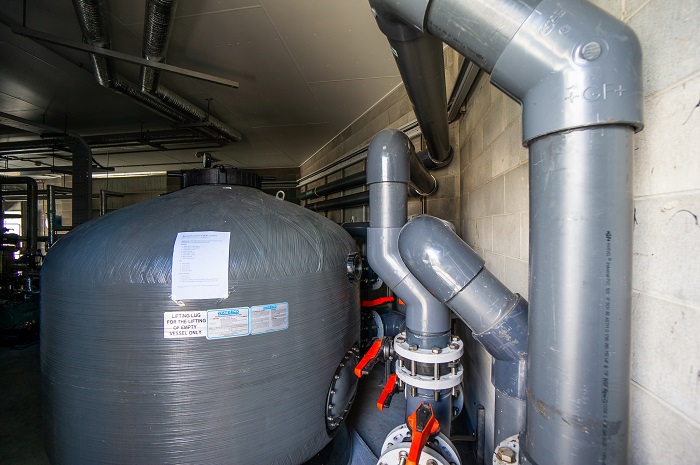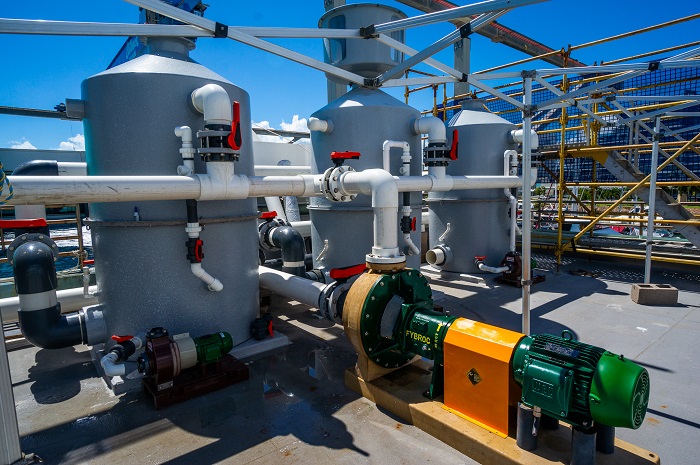In May 2020, the Great Barrier Reef Aquarium received $2.6 million as part of the Government’s COVID-19 Relief and Recovery Fund to assist Great Barrier Reef Tourism and the North Queensland (Australia) regional economy.
This investment was to upgrade life support systems throughout the Aquarium. Life support systems are crucial in maintaining temperature, salinity, filtration and water quality, ensuring optimum conditions for the care and welfare of our animals.
Reverse osmosis in an aquarium removes salts and impurities from the water. Our system is a reverse osmosis machine, in that is concentrates the salinity in our tanks, which we require for our corals and marine life. It also displaces freshwater received through rain during the wet season.
Our previous machine was installed in 2011 and could produce 9,000 litres per day. Each new system will displace 22,000 litres of freshwater per day, enabling one machine to remove around 70mm of rain from the coral reef exhibit per day. As we installed two reverse osmosis machines, the system can displace up to 44,000 litres per day! This has increased our previous capacity almost five-fold.
During a significant rain event that occurred in Townsville (where the Aquarium is located) in 2019, our previous machine couldn’t maintain salinity levels or keep up with the 1500ml of that entered the coral reef exhibit. Staff were onsite and manually added 25 tonnes of salt to ensure salinity levels remained optimum. As corals are sensitive animals, a sudden decrease in salinity would have been catastrophic.
The two systems were commissioned on Boxing Day in 2020. In the first three weeks of its operation, the Aquarium received 622ml of rain, equating to 390,000 litres of freshwater entering our coral reef exhibit (for perspective, this is the equivalent to just over half the predator tank). The new machine was running 24-hours a day. The salinity concentration over those 3 weeks didn’t drop more than 1 part, maintaining at, or close to, our optimal level of 35 parts per thousand. This is a testament to the equipment and upgrades to technology, which are essential to ensure our systems can keep up with consistent rainy days during our tropical wet season.

Sand filters are a mechanical filtration system that traps suspended particulates and removes them from the water, ensuring water clarity.
Our previous sand filters were located in a gated area in Kelleher Place. These sand filters were at the end of their life and needed to be removed (or relocated) to allow space for a new Ergon Padmount transformer and a new fire hydrant booster pump.
Our new sand filters have been installed (one in the in the generator room for the coral reef exhibit) and (two in the Glaciem Room for the predator tank), which are enclosed rooms on level one of the Aquarium, next to the predator tank.
There were many challenges in the installation:
Despite the challenges of installing the sand filters in the new location, the space is more secure and improved for staff who work with the equipment. The location also aids in improved efficiencies in the sand filter system as it is closer to the water source. This, coupled with highly durable and efficient pumps, minimizes energy use compared with the previous system setup.
The sand filters are used to remove particulates from the water, by forcing water under pressure through micron media. In the case of our new sand filters, recycled glass. The glass simply catches or traps the waste particles, which helps with the water clarity by reducing the amount of particles floating around in the tanks. They also help catch particles before they settle on the bottom of the tanks.
The two predator tank sand filters are holding 3150 kilograms of recycled glass media, while the coral reef exhibit sand filter is holding 2250 kilograms. We are using two grades or size of glass, coarse glass media (1.7mm to 3mm size pieces) and fine glass media (0.75mm to 1.7mm size pieces). Each of the three sand filters has the bottom 1/3 of the filter filled with coarse glass media and layered on top of the coarse media is an additional 2/3’s fine glass media.
This sand filter system will be connected to our new thermal energy storage system, which uses ice to store energy and provides chilled water to cool the temperature in the coral reef exhibit when required.

Protein skimmers remove organic waste, such as fish poo, dead algae and food, from the systems.
Parts of the old protein skimmer system were at the end of their life or had broken. The system also needed to be moved, so that repairs could be undertaken on the wave machine deck, which is located at the wharf end of the coral reef exhibit.
In the new design of the system we wanted to incorporate improved degassing of ozone, to prevent any residual ozone from entering the coral reef exhibit. In our old system, from the skimmer chamber small traces of residual ozone in the water may have flowed into the coral reef exhibit. With the new system, the returning water flows from the skimmer chamber into a reservoir, where it has a longer ‘dwell time’ to degas, ensuring the ozone has dissipated before the water re-enters the coral reef exhibit.
Ozone is a naturally occurring, highly reactive form of oxygen gas comprised of three oxygen molecules that is short lived, up to 17 seconds. When ozone molecules break down, they lose one molecule to form a stable oxygen molecule (O2) and a free single oxygen atom. It is this free oxygen atom that attaches to dissolved organic compounds, such as fish poo, which breaks the molecule down again that is then removed by the protein skimmer.
This reservoir is a one-of-a-kind experimental unit. It is made from a plastic called Paneltim. Paneltim panels are an environmentally friendly product manufactured from new and recycled polypropylene and polyethylene. The panels are fully recyclable. A lot of thought was needed on design to ensure it could hold the water we required and be structurally sound. The reservoir hangs over the edge of the coral reef exhibit, which required additional support in the design to do this. As it is so large, the reservoir could not be built or transported in one piece. Instead, it was transported in two pieces, craned from the wharf to the wave deck platform and weld together onsite.
When upgrading any infrastructure, including our life support systems, we always aim to improve energy efficiencies. With the protein skimmers, we lowered the location where these sat to be on the same level as the coral reef exhibit, which means the pumps don’t have to pump the water so high ensuring there is more pumping power for filtration.
The Great Barrier Reef Marine Park Authority acknowledges the expertise, wisdom, and enduring connections that have informed the guardianship of the Reef for millennia. We pay our respects to the Traditional Owners as the first managers of this land and sea Country, and value their traditional knowledge which continues to inform the current management and stewardship of the Reef for future generations. We pay our respects to the Gurambilbarra Wulgurukaba Traditional Owners on whose land the Great Barrier Reef Aquarium is situated on. We acknowledge their connection to Country and are honoured to be collaborating with the Gurambilbarra Wulgurukaba community to co-design exhibits highlighting culture values and connections to sea Country.